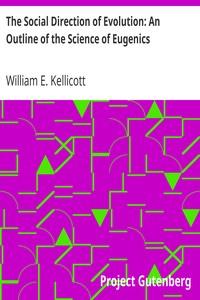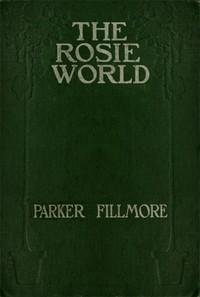Read this ebook for free! No credit card needed, absolutely nothing to pay.
Words: 33236 in 10 pages
This is an ebook sharing website. You can read the uploaded ebooks for free here. No credit cards needed, nothing to pay. If you want to own a digital copy of the ebook, or want to read offline with your favorite ebook-reader, then you can choose to buy and download the ebook.


: The Social Direction of Evolution: An Outline of the Science of Eugenics by Kellicott William E William Erskine - Eugenics
Let us have a concrete illustration. One of the simplest cases is that of the heredity of color in the Andalusian fowl which has been so clearly described by Bateson. There are two established color varieties of this fowl, one with a great deal of black and one that is white with some black markings or "splashes"; for convenience we may refer to these as the black and white varieties respectively. Each of these breeds true by itself. Black mated with black produce none but black offspring, white mated with white produce none but white offspring. Crossing black and white, however, results in the production of fowls with a sort of grayish color, called "blue" by the fancier, though in reality it is a fine mixture of black and white. At first sight we seem to have a gray hybrid race through the mixture of the black and the white races. Not so: for if we continue to breed successive generations from these blue hybrid fowls we get three differently colored forms. Some will be blue like the parents, some black like one grandparent, some white like the other grandparent. Not only this but we get certain definite proportions among these three classes of descendants. Of the total number of the immediate offspring of the hybrid blues, approximately one half will be blue like the parents, approximately one fourth black, and one fourth white like each of the grandparents. Now comes the most important fact of all. These blacks, bred together produce only blacks, the whites similarly produce only whites; the blues, on the other hand, when bred together produce progeny sorting into the same original classes and in the same proportions as were produced by the blues of the original hybrid generation. Their blacks and whites each breed true, their blues repeat the history of the preceding blues. No race of the hybrid character can be established: blues always produce blacks and whites, as well as blues. A summary of this history in graphic and diagrammatic form is given in Fig. 7.
This law of heredity was first discovered about forty-five years ago by Gregor Mendel, working with peas in the garden of the Augustinian monastery in Br?nn, Austria. His work curiously failed to arouse the interest of contemporary scientists and his results were soon completely lost sight of. The independent rediscovery of Mendel's formulas of heredity, about ten years ago, was probably the most important event in the history of biology and evolution since the publication of "The Origin of Species."
In the crossing of the black and white Andalusian fowls described above the phenomenon of dominance does not appear; when the two color characters are brought into a single individual neither appears alone, neither overcomes nor is overcome by the other. In the crossing of the black and white guinea pigs dominance is complete; when the two color characters are brought into a single individual only one color appears, the second becomes recessive, that is, it remains present as we know from the later history of such hybrids, but it is not visibly indicated. Besides the Andalusian fowls there are known several other instances of the absence of dominance and there are many cases where dominance is incomplete, i. e., where one character merely tends to dominate the other. And in a few instances dominance is irregular, i. e., sometimes one character dominates, at other times or under other circumstances it does not, as with certain forms of the comb or the feathering of the legs in the common fowl, or with the presence of an extra toe in the domestic cat, the rabbit, and guinea pig. And even in those cases where dominance is said to be complete the trained eye of the breeder can frequently distinguish between the hybrid and the pure bred dominant individuals. The phenomenon of dominance, therefore, is not an essential of the Mendelian theory although it is a frequent, we may say usual, relation.
That is, one fourth are pure black , one fourth pure white , and the remaining half are hybrids, black and white . The pure blacks again form germ cells, all possessing the determiner for blackness; the pure whites form germ cells all lacking the determiner for blackness; the hybrid blues produce again equal numbers of germ cells possessing and lacking the determiner for blackness. The relation of the germ cells and the organisms forming them and developing from them is shown in the diagram in Fig. 9.
In the more common cases where the phenomenon of dominance appears, as in the guinea pig, this is explained by saying that here a single determiner for blackness is somehow sufficient to produce the color. In such cases the black color observed may result either from a single or from a double black determiner in the germ which forms the organism. Only when the black determiner is entirely absent does the white color appear in the developed organism and the individual is then said to exhibit the recessive characteristic.
Another possible type of mating is that between a member of a pure race, either dominant or recessive, and a hybrid individual. This form of mating is very common in some of the pedigrees that we shall examine later. The results of such a mating, first between a hybrid and a recessive individual can be most easily described by considering a cross between black and white forms and expressing the result algebraically.
That is, returning to the example of the Andalusian fowls, the progeny will be one half hybrid blues and one half whites--no black at all. If the cross had been between black hybrid guinea pigs and white recessive specimens the result would have been half hybrid blacks and half pure whites.
Or supposing the mating to have occurred between the pure dominant and the hybrid the result would have been, in the fowls half pure black and half hybrid blue; in the guinea pig all the progeny would have been black, half pure blacks and half hybrid blacks.
This conception of the unit character is an extremely important element in the whole Mendelian theory and it has extended beyond the field of heredity and led to a radical change in our notions of what an organism really is. It is, of course, true in a sense that an organism is a unit, an organism is one thing; but at the same time it is true that an organism is fundamentally a collection of units, of structural and functional characteristics which are really separable things. A few of these units were mentioned in the first pages of this chapter and others are mentioned on a later page. They serve as the building blocks of organisms: individuals of the same species may be made up of similar combinations or of different combinations. One unit or a group of units may be taken out and replaced by others.
We shall have occasion in the next chapter to enumerate some of the human unit characters whose heredity has been traced and which have been found to Mendelize, but we may mention here a few Mendelizing units in other organisms in order to give some idea of the kind of character which behaves as a unit and of the range of the forms which have been found to show Mendelian phenomena in their heredity. Among the higher animals one might mention the absence of horns in cattle and sheep; the "waltzing" habit of mice and the pacing gait of the horse; length of hair and smoothness of coat in the rabbit and guinea pig; presence of an extra toe in the cat, guinea pig, rabbit, fowl; length of tail in the cat; and in the common fowl such characters as the shape and size of the comb, presence of a crest or a "muff," a high nostril, rumplessness, feathering of the legs, "frizzling" of the feathers, certain characters of the voice, and a tendency to brood. Among plants may be mentioned such characters as dwarfness in garden peas, sweet peas, and some kinds of beans; smoothness or prickliness of stem in the jimson weed and crowfoot; leaf characters in a great variety of plants; in the cotton plant a half dozen characters have been found to Mendelize; seed characters such as form and amount of starch, sugar, or gluten; flat or hooded standard in the sweet pea; annual or biennial habit in the henbane; susceptibility to a rust disease in wheat. We should not fail to mention that scores of color characters are known to Mendelize, such as hair or coat color and eye color in animals and the colors of flowers, stems, seeds, seed-coats, etc., in plants. The list of Mendelizing traits in different organisms now extends into the hundreds and is increasing almost weekly.
Before leaving the subject of Mendelism we should say that the phenomena, as described above in the Andalusian fowl and guinea pig, are among the simplest known. And while such simple formulas serve to describe the phenomena of heredity in a large number of instances, yet in a great many other cases the descriptive formulas are more complicated. We cannot in this place describe any of these complications. For a full discussion of these and of the whole subject of Mendelism the interested reader is referred to Professor Bateson's work on "Mendel's Principles of Heredity" . It must suffice to say here that in color heredity, for example, such ratios as 9:3:4 or 12:3:1 in the second filial generation instead of the more frequent 1:2:1 or 3:1 are explainable upon essentially the same relations as these simpler and more typical ratios. And further, many less usual Mendelian phenomena, which we cannot undertake to describe here, are associated with what the specialist technically terms "sex limitation," "gametic coupling," and the like.
It is often said that the Mendelian formula has a very limited applicability to human heredity. This is probably true if we consider carefully the grammatical tense in which this statement is made. And yet it is almost certainly true that heredity in man is to be described by this law. This apparent paradox is easily explained. The only characters whose history in heredity follows this formula are the unit characters. A complex trait is not heritable, as a whole, but its components behave in heredity as the separate units. It is perfectly well known that we are deeply ignorant regarding this phase of human structure. Our ignorance here is not the necessary kind, however, it is merely due to the newness of the subject--we have not had time to find out. How can we say that a complex trait is or is not inherited according to some form of Mendel's law when we do not know the nature of the units of which it is composed? We can make no statements about the Mendelian inheritance of such a trait until it is factored into its units. A considerable number of human characteristics are really known to be heritable according to this formula, enough so that several general rules of human heredity have been formulated. But it is also quite within the range of possibility that some traits really do not follow this law, although it cannot yet be said definitely that this is or is not the case. On the whole, then, we cannot, for the next few years, expect too much from the application of Mendel's laws to human heredity, however much this is to be regretted.
Free books android app tbrJar TBR JAR Read Free books online gutenberg
More posts by @FreeBooks

: 'Mid Pleasures and Palaces by McKimmey James Parsons Philip B Illustrator - Science fiction; Short stories Science Fiction


: 'A vilanza (la bilancia); Cappiddazzu paga tuttu Teatro dialettale siciliano volume settimo by Martoglio Nino Pirandello Luigi - Italian drama; Italian drama Italy Sicily IT Teatro dialettale






